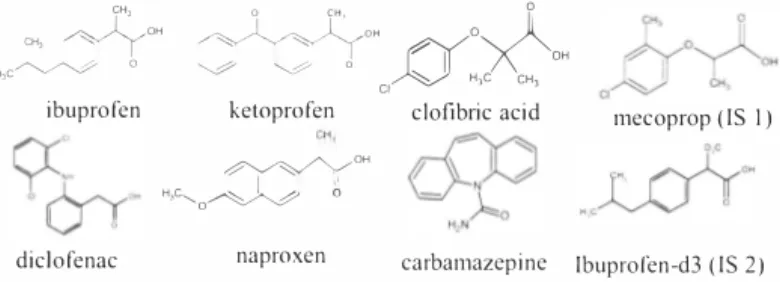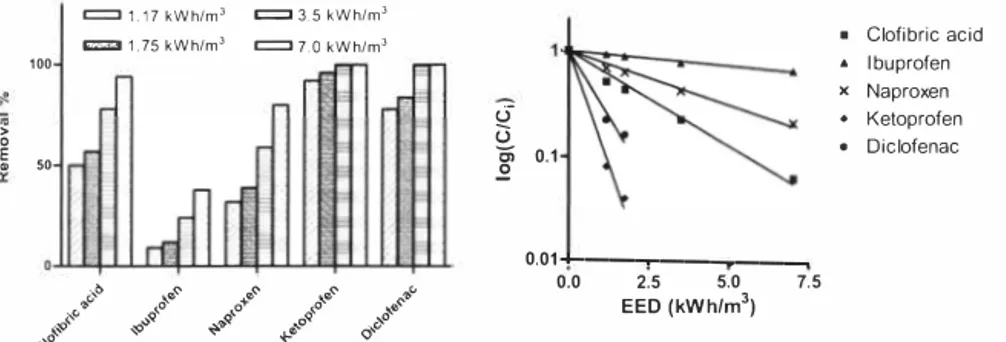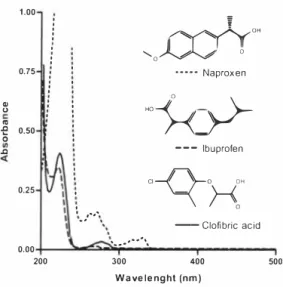Kalmar ECO-TECH '07 KALMAR, SWEDEN, November 26-28, 2007
PHOTOLYSIS AND ADVANCED OXIDATION
TREATMENT OF PHARMACEUTICALS IN TAP
WATER AND TREATED SEW AGE
Kami/la Hanse,i
1Henrik R. Anderse11
1Tina Kosjek
2Ester Heatli
2Pov/ Kaas
3Anna Ledin
4 1Technical University of Denmark, Denmark
1
Joief Stefan institute, Slovenia
3Scan Research AIS, Denmark
4Linkoping University, Sweden
ABSTRACT
The aim of this study was to investigate the removal efficiency of six phannaceuticals by photo-degradation and the advanced oxidation process (AOP), UV/H2O2. The six phannaceuticals were the four NSAIDs ibuprofen, diclofenac, naproxen and ketoprofen, the pharmacological active metabolite of the lipid lowering agent, clofibrin, clofibric acid, and the anticonvulsant and mood stabilizing drug, carbamazepine.
Treatment experiments were perfom1ed using a UV lamp optimized for photochemical treatment in a flow through set-up. For the AOP experiments 60 mg/L H2O2 was added to the water before treatment. The treatment effectiveness is evaluated based on the Electrical Energy per Order (EEO) (unit kWh!m\ which is defined as the electrical energy consumed per unit volume of water treated required for 90% removal of the investigated compound.
It was found that four of the six phannaceuticals were completely removed in tap water by both UV treatment and the AOP. The exceptions were ibuprofen and carbamazepine, which exhibited a relationship between UV dose and removal. The electrical energy per order, EEO was detennined to 8.2 kWh/ml (UV) and 3. 7 kWh/ml (UV /H
2O2 ) for ibuprofen.
In the wastewater effluent the removal by UV irradiation was almost complete for ketoprofen, while the other compounds show dependency of flow rate/UV dose. Ibuprofen was the compound that needed the highest UV dose to remove 90% (EEO = 33.4 kWh/ml) where
naproxen and clofibric acid required 9.6 kWh/ml and 5.5 kWh/ml, respectively. Ketoprofen
and diclofenac needed considerable less energy than clofibric acid. Ibuprofen and naproxen is biodegradable and will be removed in biologically treated wastewater. Therefore, the relevant estimate of the needed treatment is the energy use for removal of clofibric acid which required 5.5 kWh/ml for 90% removal.
1 INTRODUCTION
Few pharmaceuticals are not removed in conventional sewage treatment, among the most important of these in terms of high consumption volume are carbamazepine [I], clofibric acid [2] and diclofenac [I, 2]. It is known that the above mentioned three stable phannaceuticals can be photo-degraded in surface waters by sunlight [3, 4]. This is likely the most important ultimate fate of non bio-degradable and non-sorbing phannaceuticals.
The UV-absorption spectra of carbamazepine and clofibric acid [3] shows that carbamazepine absorbs from 320 nm with a local maximum at 280 nm. Clofibric acid absorbs weakly between 300 - 240 and has a local maximum at 230 nm. Sunlight has very little intensity below 280 nm and even most sunlight below 400 nm is filtered by the atmosphere. UV lamps used e.g. for photo-chemicals reactions and disinfection of water can create a many fold more intensively illumination of water with a higher fractions of light having lower wavelengths thus potentially decreasing half lives of phamiaceuticals to the seconds time scale.
The aim of this study was to investigate the removal efficiency of six pharmaceuticals by photo-degradation and the advanced oxidation process (AOP), UV /H202. The six pharmaceuticals were the four non-steroidal-anti-intlamatory drugs: ibuprofen, diclofenac, naproxen and ketoprofen, the pharmacological active metabolite of the lipid lowering agent, clofibrin, clofibric acid, and the anticonvulsant and mood stabilizing drug, carbamazepine. 2 METHOD
2.1 Reagents and materials
All the drugs investigated (ibuprofen (CAS 15687-27-1), diclofenac sodium salt (CAS 15307-79-6), naproxen (CAS 22204-53-1), ketoprofen (CAS 22071-15-4), clofibric acid (CAS 882-09-7), and carbamazepine (CAS 298-46-4)) were supplied by Sigma-Aldrich (Gillingham, UK) as well as the derivatisation agent MTBSTFA (N-methyl-N-(tert-butyldimethyl-silyl) tri tluoracetamide ). The internal standards mecoprop (2-( 4- chloro-2-methylphenoxy) propanoic acid) and d3-ibuprofen were obtained from Labor. Dr. Ehrenstorfer- Schafers (Ausburg, Germany). Methanol, acetone, toluene, ethyl acetate, 30% hydrogen peroxide, and 37% hydrochloric acid were of analytical grade and were provided by Merck (Dannstadt, Gem1any).
The water used for the experiment was either tap water or wastewater. The tap water contained chlorine which was removed by irradiating the water in the reactor at slow flow rate which correspond to an electric energy dose of 18 kWh/m3. The water was collected in 20 L containers. The wastewater was provided by the wastewater treatment plant, Centralna Cistilna Naprava Ljubljana.
�
\� .
.-�,
/Kalmar ECO-TECH '07
KALMAR, SWEDEN, November 26-28, 2007 °
�
I'
,OH� 1 �
_r
_ o ,°'' / --.__y- y / "-Y' y' "-Y'
i
1/' 00OHH,C � 0 � � o
Cl
� H,C CH,
ibuprofen ketoprofen clofibric acid mecoprop (IS I)
<>, H.ic, � o
0
naproxen
diclofenac carbamazepine lbuprofen-d3 (IS 2)
Figure I, Six pharmaceuticals investigaded in this study and the internal standards.
2.2 Bench scale reactor
The treatments were carried out in a bench scale, flow through photoreactor (see Figure 2). The lamp (Bau4 7-700W, Scan Research A/S, Heming, Denmark) is located coaxial in the centre of the reactor. The UV-lamp was placed inside a quarts sleeve which is pumped with an inert gas to avoid ozone formation. The distance from the lamp to the inner side of the reactor is 5. 7 cm.
Figure 2 shows a photo of the experimental set-up and schematically drawing. The water was
pumped from the plastic containers through a flowmeter and into the reactor at the bottom. A valve was used to adJust the flow rate. The samples for analysis were taken from the outlet after one retention time and from the containers (inlet concentration). The blind sample was taken before spiking and addition of hydrogen peroxide.
2.3 Sample analysis
The samples from the experiments with wastewater were filtered, first with glass pre-filter (GF 92, Schleicher & Schuell, Dassel, Germany) then with OAS µ111 membrane filter (Nylon 66, Supelco, Bellefonte, PA, USA).
Both tap water and wastewater samples were acidified to pH 2.6 with HCL The internal standards were added before solid phase extraction. For wastewater samples both mecoprop and ibuprofen-d3 were used while only mecoprop was used in tap water samples.
Container
--1
''
--
Outlet lnlet·--I
L
,
,,
\
_
__)
Reactor PumpThe SPE-columns were conditioned with 3 ml ethylacetat, 3 ml methanol, and 3 ml water, which was pH adjusted to 2.6. The samples were loaded on the SPE-columns at a flow rate of 2 ml/min, which afterwards were dried for I hour using vacuum. The SPE-columns were eluted with 3 ml ethylacetat, which were evaporated until approximately 0.5 ml under a stream of nitrogen and transferred to GC-vials and derivatised by adding 50 µl of MTBSTF A. The GC-vials were then placed in an oven at 60°C for 60 min.
The analysis of the derivatised drugs was preformed by GC-MSO on an HP 6890 instrument (Hewlett-Packard, Waldbron, Germany) fitted with a 30 m x 0.25 mm x 0.25 µm HP-5 MS capillary column (Hewlett-Packard). The carrier gas was helium at a constant velocity of 37 cm/s. Injection was performed in the splitless mode at an injection temperature of 250° C The injection volume was I µL The GC oven temperature was maintained at I 00°C for I min then programmed at 30°C/min to I 90°C, then at 3°C/min until 204°C, followed by 30°C/min to 245°C, subsequently 5°C/min until 265°C, and finally 30°C/min to 300°C, which were hold for I min when drinking water samples were analysed and for 5 min for samples with wastewater effluent.
2.4 Data treatment
The treatment effectiveness is evaluated based on the Electrical Energy per Order (EEO) (unit kWh!m\ which is defined as the electrical energy consumed per unit volume of water treated required for 90% removal of the investigated compound [5].
The normalised concentration of the investigated chemicals was plotted against the electrical energy dose. These plots were used for estimation of the electrical energy per order. The curves were fitted to the data using nonlinear regression.
(CJ -I
log - =-- EEO (I)
C, EEO
;where C, and C is the initial and the final concentration, respectively, EEO is the electrical energy dose in kWh/m3 and EEO is the electrical energy per order.
The regression is done by minimizing the sum-of-squares of the vertical distances of the data from the curve. The points were weighted by I/Y2 (relative weighting) [6],
3 RES UL TS AND DISCUSSION
3.1 Removal rates
Figure 3 shows the results from treatment of drugs in tapwater at different electrical energy
dose. It is seen that I 00 % removal is obtained for four of the drugs for both treatment methods and at the most of the EEO, Only at the lowest EEO (where the water is exposed to the smallest UV dose), is the degradation of some of the compound not completely, There is no removal of carbamazepine when the tap water is exposed to the lowest UV dose without
H2O2. Ibuprofen is only completely removed at the highest EEO and shows a relationship
'°
�·,,.,,
,o
Kalmar ECO-TECH '07 KALMAR, SWEDEN, November 26-28, 2007
c:::=J 1.8 kWh/m 3 � 3.5 kWh/m 3 �9.0 kWh/m 3 c:::::::::J 21 kWh/m 3 (a) c:::I 1.8 kWh/m 3 c:::::::13.5 kWh/m 3 i:=:J 7.0 kWh/m 3 (b) 100 100 ;; > 0 50 50 le I
Figure 3. The removal of phar111aceuticalsfi·o111 lap water at different electrical energy dose by (a) photolysis and (b) ADP (initial concentration of H:O: were 60 mgll), Initial concentration of the pharmacelllicals was IO µgll.
The results from UY-treatment of the phamiaceutical spiked in wastewater effluent are shown in Figure 4, Ketoprofen and diclofenac were almost I 00% removed at the used EEO, while the removal of clofibric acid, ibuprofen and naproxen shows a dependency of the EEO, The analysis of carbamazepine was not successful in the wastewater effluent.
c:::::I 1.17 kWh/m 3 c=:::::::J 3.5 kWh/m3 100 > 0 E o 50 EZiZa 1.75 kWh/m3 c:::::I 7.0 kWh/m 3
c5
u
01 0.1 .2 0.01_.__--�---� • Clofibric acid • Ibuprofen x Naproxen • Ketoprofen • Diclofenac 0.0 2.5 5.0 7.5•"
,.�
3.,.
•"
o+.,,
,o,.,,
EEO (kWh/m) i:-" ,.q ,o q oq +-e,.._ Q'" .,..,'"°
Figure 4. The removal ofphwmaceuticals Figure 5. Regression lines for estimation of
J,-0111 wastewater e/jluenl by photolysis at ££O/orfive pharmaceuticals treated by
different electric energy dose, Initial photolysis.
3.2 Energy efficiency
Table 1 shows the values of EEO for the pham,aceuticals. Less energy is requires to remove
the phannaceuticals from tap water than from wastewater effluent, which is as expected. The reason that the organic and inorganic compounds act as scavenger for radicals in wastewater effluent and will absorb or reflect part of the UV light.
It was found in the treatment experiments in tapwater that carbamazepine was the compound which was most difficult to remove (the highest EEO value) and that ketoprofen and diclofenac was totally removed at the used energy doses. The addition of H202 resulted in a lower value of EEO for carbamazepine and ibuprofen. The EEO which is estimated on basis of two points contains some uncertainty and the value would probably be a lower since complete removal was obtained for EEO larger than 1 . 8 kWh/ml .
In the wastewater effluent ibuprofen is the compound that need the highest energy dose to remove 90% (EEO = 33.4 kWh/ml) where naproxen and clofibric acid required 9.6 kWh/ml
and 5.5 kWh/n,3, respectively. Ketoprofen and diclofenac needed considerable less energy
than clofibric acid. Ibuprofen and naproxen is biodegradable [2] and will be removed in biologically treated wastewater. Therefore the relevant estimate of the needed treatment is the energy use for removal of clofibric acid which required 5.5 kWh/m3 for 90% removal. 3.3 Absorption
That naproxen was harder to degrade than diclofenac, comply with what Packer et al. [7] found in their investigation of photodegradation of four pham,aceuticals. It was found that clofibric acid is easier to remove than naproxen, which is in contrary to what Packer et al. [7] found. Packer et al. [7] did not degrade ibuprofen, which also is the most difficult to remove (see Table 1).
The absorption spectra of naproxen, ibuprofen and clofibric acid are shown in Figure 6. It is seen that ibuprofen and clofibric acid only absorb light under 300 nm with a local maximum at approximately 225 nm. Naproxen absorbs more light in the UY-range than ibuprofen and clofibric acid.
Table 1. The electrical energy per order (kWh/1113) with 95% confidence interval .for the pharmaceuticals in lap water and wastewater by photolysis and advanced oxidation (60 mg H202/L).
Tap water Wastewater effluent
UV UY/H202 UV
EEO± 95% Cl EEO± 95% Cl EEO± 95% Cl
Clofibric acid 1 .6' 5.5 ± 0.6 Ibuprofen 8.6 ± 4.4 3. 7±0.e7 33.4 ± 3.4 Naproxen 2.1 ± 0.9 2.2" 9.6 ± I. I Ketoprofen 1 .2 ± 0.3 Diclofenac 2.0 ± 0.6 Carbamazepine 22. 7 ±4.1
__
DYYOH
Kalmar ECO-TECH '07 KALMAR, SWEDEN, November 26-28, 2007
1,00
. .
' '.
.
' '.
'-o 0,75.
'.
••••• Naproxen '. .
.,
'.
.
.
HO 0.
i-0-->-"'
' ,c 0 0,50.
' --- Ibuprofen ,c. .
c, o OH -q-0,25.
..
_,, ....
..- Ko
-- Clofibric acid ..�...
0,00 200 300 400 500 Wavelenght (nm)Figure 6. Absorption Jpectra and molecule structure of naproxen, ibuprofen, and cloflbric acid.
Packer et aL [7] used natural sunlight as light source, Ozone in the atmosphere absorbs most of the radiation with a wavelength under approximately 280 nm. If the light only have radiation with a wavelength above 280 nm, degradation of ibuprofen and clofibric acid will not occur. It is understandable that Packer et aL [7] were unable to degrade ibuprofen as it does absorb minimal at wavelength above 240 11111, The UV lamp used in this study did emit light with low wavelength and the probability of degrading clofibric acid and ibuprofen will be improved. It is not only the absorption spectra but also the quantum yield that influence the possibility to degrade a compound. The quantum yield of clofibric acid is likely to be higher than the one for ibuprofen since their absorption spectra are very much alike and clofibric acid is a lot easier to degrade than ibuprofen.
ACKNOWLEDGEMENTS
The Siemens Foundation, the EU Life project, APOP, and the Danish Research council project, DanEd, is gratefully acknowledged for economic support, Further, technical assistance with analysis by Silva Perko is recognized.
REFERENCES
[!] Clara,M., Strenn,B., Gans,O., Martinez,E,, Kreuzinger,N., Kroiss,H,, 2005. Removal of selected phannaceuticals, fragrances and endocrine disrupting compounds in a
[2] Kosjek T., Heath E., Kompare B., 2007. Removal of pharn1aceuticals residues in a pilot wastewater treatment plant. A nalytical and Bioanalytical Chemistry. 387/4: 1 379- 1 387
[3] Doll, T.E., Frimmel, F.H., 2003 . Fate of phannaceuticals--photodegradation by simu lated solar UV-light. Chemosphere 52 ( I 0), 1 757- 1 769.
[4] Petrovic, M., Barcel6,D., 2007. LC-MS for identifying photodegradation products of pharn1aceuticals in the environment. Trends in A nalytical Chemist,y 26 (6), 486-493.
[5] Bolton, J . R., Bircher, K. G., Tumas, W., Tolman, C. A., 200 1 . Figures-of-merit for the technical development and application of advanced oxidation technologies for both electric- and solar-driven systems. P11re and Applied Che111is11y 73 (4), 627-638.
[6] GraphPad Software Inc .. GraphPad Prism 5.0 - Regression Guide. http://www.graphpad.com/help/Prism5/, Septemper 1 8th, 2007.
[7] Packer, J. L., Werner, J. J., Latch, D. E., McNeil!, K., Arnold, W . A., 2003 . Photochemical fate of pharmaceuticals in the environment: Naproxen, diclofenac, clofi bric acid, and ibuprofen. A q11atic Sciences 65 (4), 342-35 1 .



